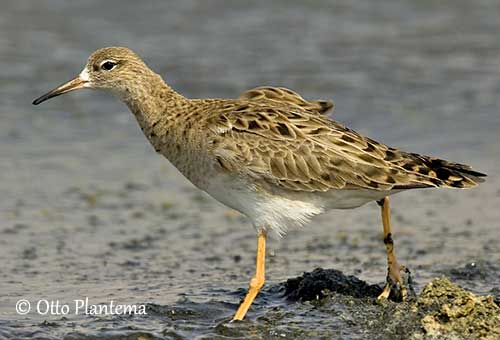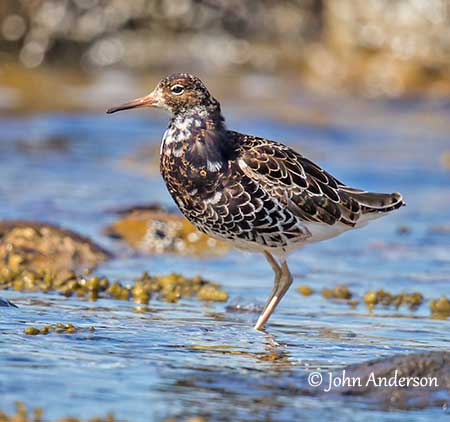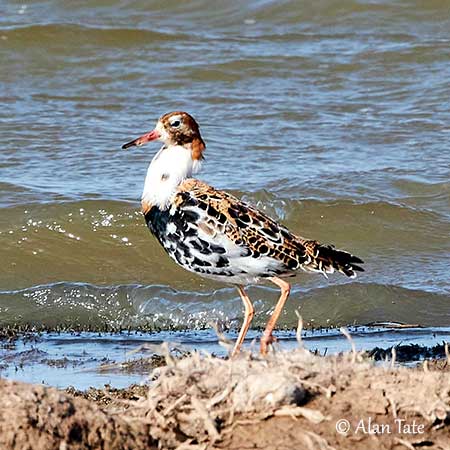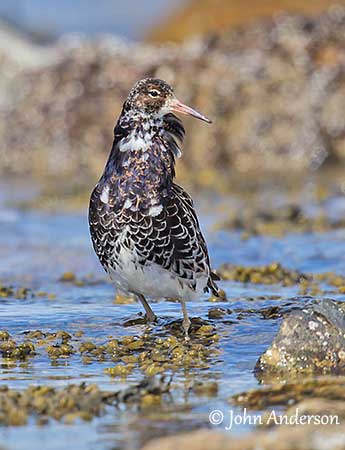
Fr : Combattant varié
Ang : Ruff
All : Kampfläufer
Esp : Combatiente
Ita : Combattente
Nd : Kemphaan
Sd : Brushane
Photographers :
John Anderson
John Anderson Photo Galleries
Steve Garvie
RAINBIRDER Photo galleries & Flickr Rainbirder
Tom Grey
Tom Grey's Bird Pictures & Tom Grey's Bird Pictures 2
Otto Plantema
Trips around the world
William Price
PBase-tereksandpiper & Flickr William Price
Alan & Ann Tate
AA Bird Photography
Text by Nicole Bouglouan
Sources :
HANDBOOK OF THE BIRDS OF THE WORLD Vol 3 by Josep del Hoyo-Andrew Elliott-Jordi Sargatal - Lynx Edicions - ISBN : 8487334202
THE COMPLETE BOOK OF BRITISH BIRDS – Written by “Royal Society for the Protection of Birds” experts - Préface de Magnus Magnusson - Michael Cady- Rob Hume Editors - ISBN: 0749509112
THE HANDBOOK OF BIRD IDENTIFICATION FOR EUROPE AND THE WESTERN PALEARCTIC by Mark Beaman, Steve Madge - C. Helm - ISBN: 0713639601
A Field Guide to the Birds of South-East Asia by Craig Robson. New Holland Publishers. ISBN: 9781780090498
SHOREBIRDS by Peter Hayman, John Marchant and Tony Prater – Christopher Helm – 1986 – ISBN: 0747014035
GUIDE DES LIMICOLES de D. Taylor - Delachaux et Niestlé - ISBN : 2603014080
Bird Web (Seattle Audubon Society)
Wikipedia, the free encyclopaedia
What Bird-The ultimate Bird Guide (Mitchell Waite)
The faeder identity – A third male type in ruffs
Ruff (Philomachus pugnax) movements
Male ruff birds cross-dress to steal females, and it’s all in their genes
CBC Radio -Ruff sex: Scientists identify genetic sequence of a bird with four genders
New Scientist - Ruff bird orgies have four ‘sexes’ thanks to a supergene flip
Ruff research: Genetic quirk gives rise to three types of male bird
Ruff
Philomachus pugnax
Charadriiformes Order – Scolopacidae Family
INTRODUCTION:
The Ruff is well known for its spectacular appearance in breeding plumage, but also for its amazing courtship displays on a lek. It is probably the most variable of waders, and the males are about 25% larger than the females (also known as Reeves).
The Ruff is migratory. It breeds in colder regions of N Eurasia, and spends the winter in Africa, Middle-East, India and SE Asia. During the breeding season, it frequents lowland freshwater marshes and other wetlands, but it avoids the barren tundra. They travel in large flocks and form huge groups on the wintering areas where they can be seen on wet meadows and muddy areas around pools and lakes.
The Ruff is threatened by pollution and drainage of wetlands, and the populations are decreasing throughout the range. But currently, the species is not globally threatened.

DESCRIPTION OF THE BIRD:
Biometrics:
Male:
Length: 26-32 cm – Wingspan: 54-58 cm – Weight: 130-254 g
Female:
Length: 20-25 cm – Wingspan: 48-52 cm – Weight: 70-170 g
The Ruff shows an extreme sexual dimorphism, and the male’s ornaments differ individually in pattern and coloration.
The male in breeding plumage has black barred lower back and tail. Mantle and scapulars vary from black to brown, chestnut, ochre and white.
The underparts are mostly dark, except the white lower belly, underwing and undertail.
Head-tufts and ruff are highly variable in colour, including buff, chestnut, black-purple, black or white plumage, often with barred or flecked pattern.
The bill is brown or dull orange. The eyes are dark brown. Legs and feet are greenish-yellow to bright orange. The facial warts vary from greyish to yellowish, orange or reddish to brown.
Males have a hierarchy based on plumage colour while displaying. The males “resident” or “independent males” have darker plumage, especially head-tufts and ruff, whereas “satellite males” are slightly smaller and usually have white or very pale ruff and tufts.
These ornamental feathers are visible for relatively short time, usually April to June. Outside this period, the male resembles female or Reeve in shape and plumage, but it is significantly larger.
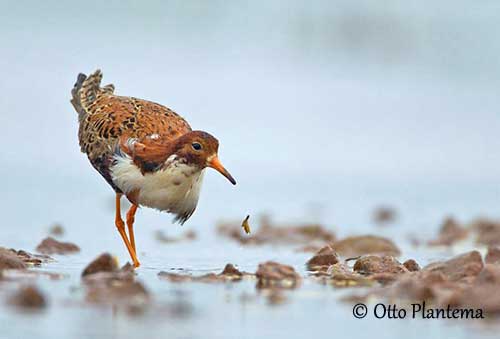
The moulting male often has extensive black blotching on breast, whereas face and head are whitish.
The female is much smaller than male. She has rather variable colour overall, with heavily scaled head, neck and breast. The upperparts show extensive blackish feather centres, like on breast sides and flanks.
She lacks the ornamental head plumage of the male. The bill is black. Legs and feet are pinkish-orange, green or grey.
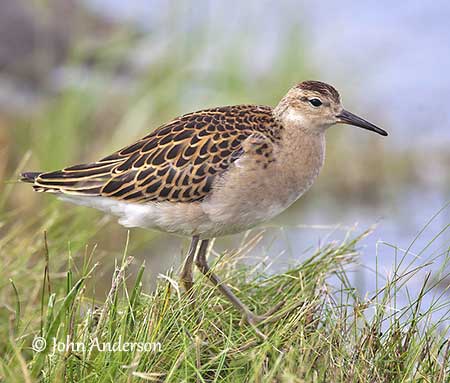
The non-breeding male resembles breeding female but the upperparts are paler grey-brown. The lower face is whiter and the beast is tinged dusky buff. The bill is dark and legs and feet are much duller.
Some birds may have white head and neck.
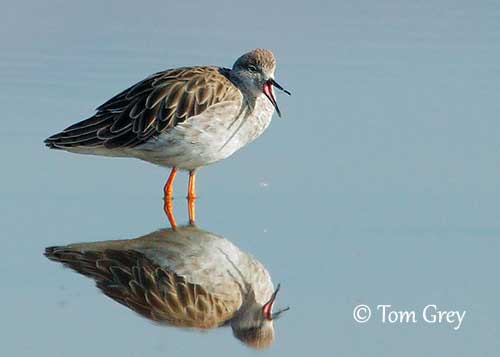
The juvenile has dark upperparts with buff-fringed feathers creating a strong scaled pattern. Foreneck, breast and belly are more rufous but the throat is paler and the face is buff. Bill and legs are like in breeding female.
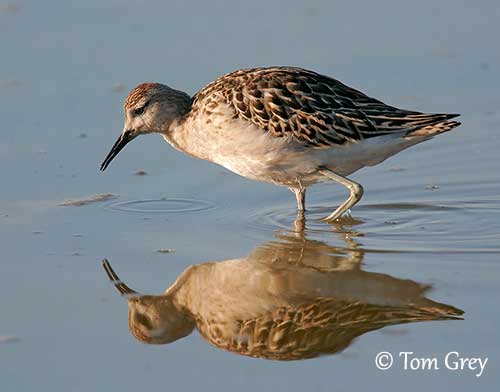
RANGE:
The Ruff breeds in NW and N Europe, E through Siberia to Chukotskiy Peninsula and Sea of Okhotsk. It winters from the coasts of W Europe and Mediterranean to sub-Saharan Africa, through Middle-East to Indian Subcontinent and SE Asia. It also occurs in Greater Sunda Islands and Philippines.
It frequents cool temperate areas in Europe, but it is an Arctic species over the Russian range.
HABITAT:
The Ruff breeds in lowland freshwater marshes and swampy grasslands, avoiding the barren tundra and areas exposed to bad weather.
The wet areas provide sources of food, mounds and slopes are used for displaying on leks, and the nesting sites are mostly in dry areas with sedges and low scrubs.
Outside the breeding season, the Ruff frequents a variety of shallow wetlands including the muddy margins of freshwater or brackish lakes and pools. It also occurs in ricefields, flooded grasslands and less frequently tidal mudflats.
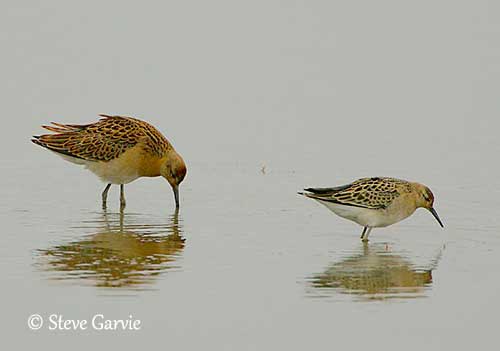
CALLS AND SONGS: SOUNDS BY XENO-CANTO
The Ruff is rather silent, even during the breeding season. However, a low “kuk” or “kuk-kuk” is sometimes given in flight, whereas the feeding birds may produce low, hoarse grunts “kurr” and “kook” also heard in winter flocks, and at the leks. The female disturbed at nest also produces this type of call. The migratory flocks give shrill, rising “hoo-ee”.
BEHAVIOUR IN THE WILD:
The Ruff feeds primarily on insects and other invertebrates, and occasionally on seeds. Insects include flies, beetles and caddisflies. It also takes molluscs, crustaceans, small fish, frogs, worms and spiders. However, many seeds are consumed during migration and winter.
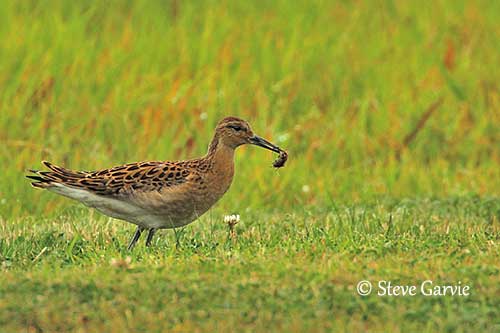
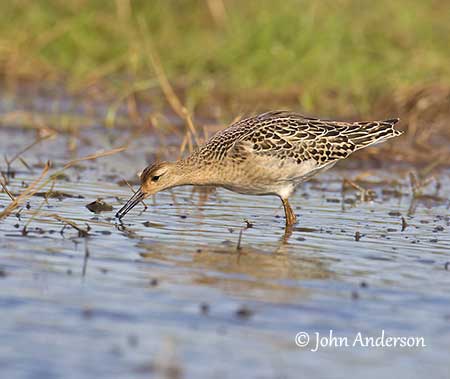
The Ruff forages by walking and wading in shallow waters, although it may wade in fairly deep waters too. It picks up prey from the surface, but it also probes in both water and mud. It may sometimes become more active and can be seen running about over open mudflats. It is both diurnal and nocturnal.
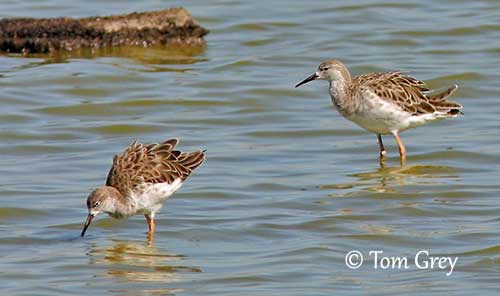
In spring, at the beginning of the breeding season, numerous males gather on leks and compete for potential matings. Ruffs, head-tufts and wattles are used for displaying, whereas wings and strong legs are used as armour and weapons.
The males have a hierarchy with the “resident” or “independent males” defending an area on the lek. They usually have dark ornamental plumage, ranging from black and brown to buff and chestnut.
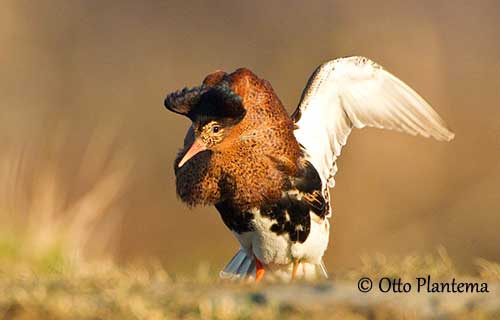
The “satellites” have paler, often white, ornamental plumage. They do not defend their own area, but they are accepted on the lek where they can “steal” matings. They are often smaller than “resident” males.
During the displays, males adopt a series of stereotyped postures. They raise both head-tufts and neck ruff, and their wings are fluttering. The male spreads its wings fully and jumps into the air, and during the “hovering-display” it may rise a few metres into the air. Other postures include bowing, crouching with fluffed up feathers or standing erect.
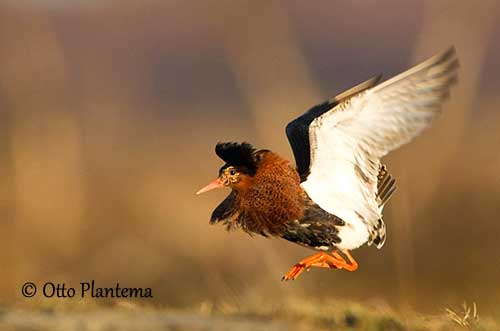
There is a third male form, a very rare variant with female-like plumage. They are known as “faeders” and are slightly larger than a female. They are genuine males but they hide their male nature and retain their inconspicuous female-like appearance.
Such males pursue a different mating strategy, but they do not fight or compete in display. However, they move freely among the territorial males. They usually “steal” copulations with females, but perhaps the females have a choice. This form was described in 2006 from Netherlands.
Fighting between males is usually rare, but sometimes, rivals jump at each other with the claws towards the bare facial skin of the other male, involving sometimes drawing blood.
The female visits the lek and mates with the chosen male. After mating, she takes on the entire responsibility of caring for eggs and chicks.
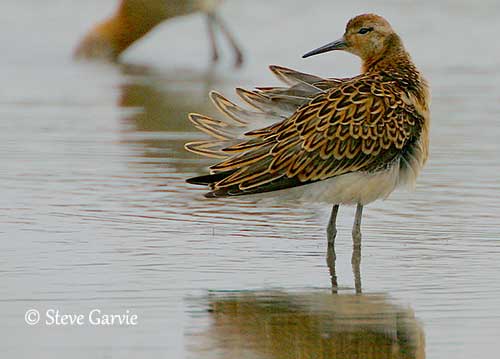
The Ruff is migratory. The autumn migration starts late June/early July (males), mid-July (females) and late July to August (juveniles). There are important staging and moulting areas around the North Sea, W Germany and N Caspian Sea. They reach Senegal from mid-July and tropics in late August to September.
The spring migration starts in March, usually March to mid-May. Some non-breeders remain in the wintering areas. The breeding grounds are reoccupied in mid-April in W Europe, later in Siberia, from mid-May to June.
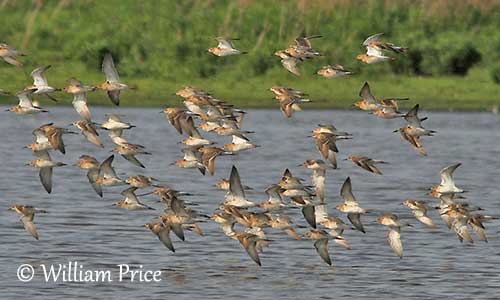
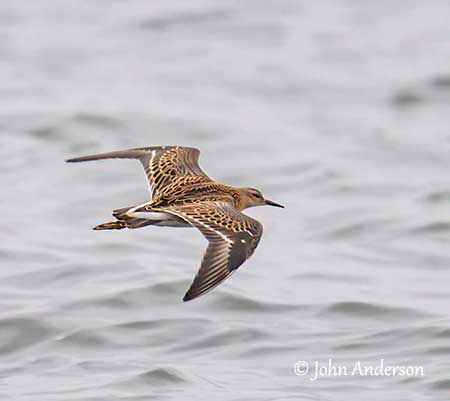
REPRODUCTION OF THIS SPECIES:
The Ruff breeds in spring, with the laying in early May in NW Europe, mid-May in Sweden and early June in Finnmark.
These birds are polygynous with no true pair-bond. They nest solitary or can be loosely colonial with widely spaced nests.
The nest is on the ground, a shallow scrape lined with grasses and leaves, well-hidden among the marshy vegetation. It is built by the female alone.
She lays 2-3 or 4 olive to green eggs with brown markings. She incubates alone during 20-23 days. At hatching, the chicks have ochre-orange down above, streaked black and brown with two lines along the crown. The underparts are buff.
The chicks leave the nest soon after hatching and the female feeds them during a few days before leaving them some days before they fledge, about 25-28 days after hatching. They can breed at two years old.
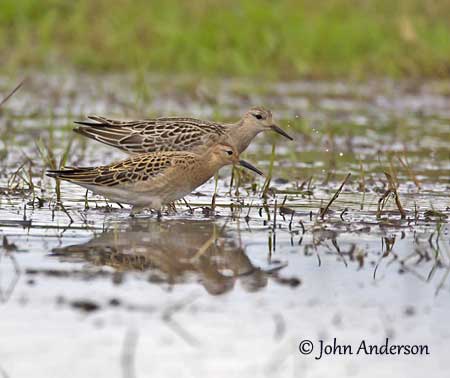
PROTECTION / THREATS / STATUS:
The Ruff is threatened by habitat loss through drainage of wetlands and flood-plains for irrigation and water management. Pollution and changing land management involve scrubs and reed invasive overgrowth.
The global population is estimated to number 2,000,000/2,600,000 individuals (2006). The population trend is decreasing but some populations appear to be stable and even increasing in E Russia, whereas in Norway and Finland, the range has expanded S since 1940s.
The Ruff is currently evaluated as Least Concern.
